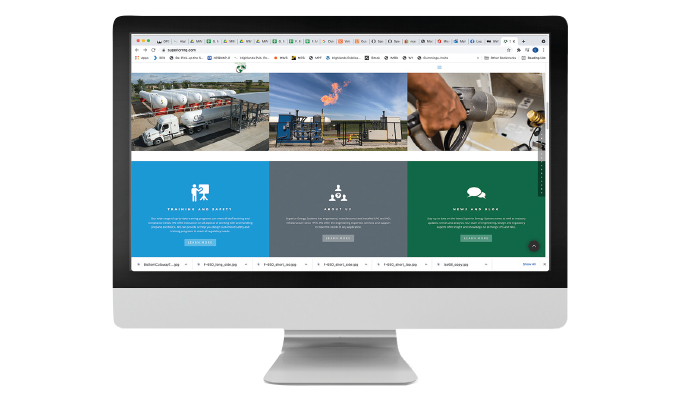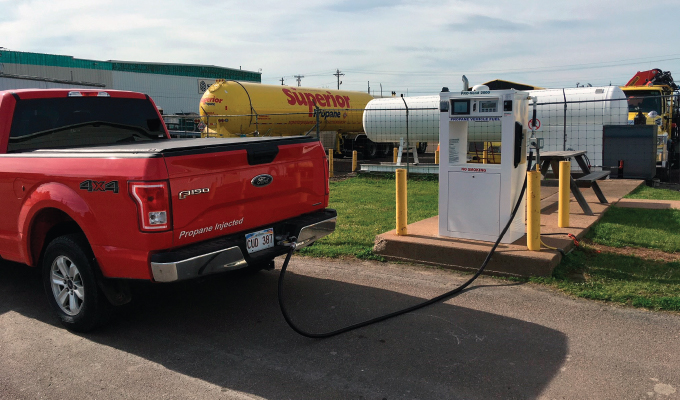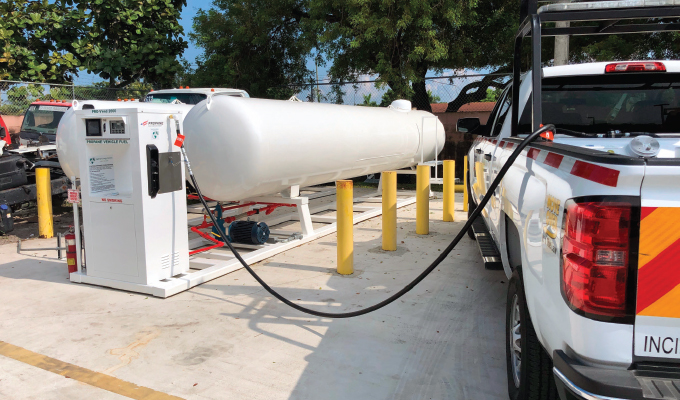By Todd Mouw
From the outside of a propane autogas truck, you won’t see much of a difference between it and a conventionally fueled truck—except for some well-placed graphics or stickers. It’s the inner workings that make these vehicles emissions reducing, low carbon, and economical.
PROPANE AUTOGAS PRIMER
Let’s begin with understanding the fuel itself. Propane autogas is the internationally recognized term used for propane when used in on-road engines. According to the World LP Gas Association, there are more than 27 million on-road vehicles fueled by propane autogas around the world. Propane autogas is the leading alternative fuel in the United States and the third most commonly used vehicle fuel, following gasoline and diesel. In the US, there are over 37,000 propane autogas-fueled vehicles equipped with ROUSH CleanTech technology on the road.
You don’t need to have a large fleet to garner the benefits—current propane technology enables you to order the number of vehicles you need, whether that’s one or a dozen, or more than 100. This is especially attractive to companies that want to adopt new fuel technology as current aging vehicles need replacement.
There are several funding opportunities available to help pay for these alternative fuel vehicles. The US Energy Department’s Alternative Fuels Data Center lists state and federal funding opportunities and possible tax credits.
Propane autogas vehicles all run on nontoxic, colorless, and clean-burning propane autogas, which is an approved alternative fuel under the Clean Air Act. In contrast to nontoxic propane, as little as one gallon of spilled gasoline can quickly contaminate groundwater above drinking water health advisory levels.
Currently, more than 90% of US propane supplies come from domestic production, making propane autogas a readily available alternative to imported oil. Propane autogas is an abundant, American-made fuel. Our country produces billions of gallons of propane and uses about 9 billion gallons for home heating, cooking, and transportation. This leaves a surplus for fleets to use this domestic energy source.
PROPANE DEVELOPMENTS
Propane autogas vehicles have been around for well over a century. But in the last decade, innovations have greatly improved the technology. The vapor-carbureted systems of the past have been replaced by modern liquid fuel-injection systems. In a liquid system, liquid propane autogas is injected directly into each cylinder’s intake port. The liquid fuel vaporizes in the cylinder, cooling the air and resulting in no loss of horsepower, torque, or engine performance. With propane’s octane rating of 104, the engine is “detuned” to match the gasoline horsepower and torque numbers.
Many equipment suppliers manufacture propane fuel systems. For example, ROUSH CleanTech’s dedicated liquid propane autogas fuel system integrates into Ford commercial medium-duty Class 4-7 trucks. The fuel lines follow the original equipment manufacturer’s routing, and the fuel tank generally replaces the standard tank location. The system delivers propane autogas to the engine in liquid form.
Recently, Ford introduced its new 7.3-L V8 engine to replace the 6.8-L V10 engine. The 7.3-L engine has two less cylinders and a single cam shaft, is 10% less on height and weight, has a much simpler belt design, and is matched with the 6R140 transmission. Together, these advancements provide a simpler design with power.
With Ford’s innovation comes developments in the propane fuel system as well. The all-new engine platform includes a new mounting bracket over the intake manifold. This positions the fuel rail pressure control module (FRPCM) over the center of the engine for easy service access. It also supports the now forged-aluminum fuel rails and gives secure mounting locations for all of the stainless steel fuel lines in the engine bay.
SYSTEM COMPONENTS
ROUSH CleanTech’s anodized aluminum fuel rails operate under the varying pressures and temperatures of liquid propane autogas. The FRPCM improves vehicle start-up times, lowers start-up emissions, and provides consistent power. The propane fuel tank meets ASME certification standards. It’s designed and manufactured to be 20 times more puncture-resistant than gasoline tanks.
The design of the industry-standard quick connect fill valve allows for safe passage of liquid propane autogas into the truck. It also includes a check valve to prevent fuel leaks. The fuel lines, made of high-durability stainless steel to handle varying temperatures and pressures, are designed to route through the factory line locations.
To operate properly on propane autogas, fuel system manufacturers will reprogram the on-board computer that controls the engine. Fuel injectors inject liquid propane autogas into the engine for ignition.
HOW TO OPERATE
Advancements in propane fleet vehicle technology have improved to where thousands of fleets across the nation rely on them to meet their company’s needs. “Our top priority is to operate a clean and safe fleet,” says Peter DeVito, CEO of dnata catering USA, one of the world’s largest air service providers. “With propane vehicles, we reduce emissions without sacrificing safety or performance.”
Jason Lee, general manager of HACOR, agrees, “The versatility and reliability of our propane vehicles allows us to operate our standard delivery and operating methods but with a low-emission fuel.” HACOR delivers up to 15,000 airline meals per day out of Los Angeles International Airport.
With conventional fuel prices constantly in flux and the federal government enacting stricter environmental controls, the total ownership cost of conventionally fueled trucks is heading upward. This trend creates a well-timed opportunity to transition your work trucks to clean-burning, cost-effective propane autogas and help reduce your carbon footprint.
STEPS TO INSTALLATION
Converting a work truck’s gasoline or diesel fuel system to operate on propane autogas is performed by an outside upfitter or the manufacturer of the fuel system which, in this scenario, is ROUSH CleanTech. Here are the nine steps it takes the ROUSH CleanTech team to convert a Ford F-450 truck to operate on propane autogas:
Step 1: Remove the factory fuel tank to install the propane tank.
Step 2: Install the fuel lines and fuel filters inside the frame channel.
Step 3: Disconnect the original fuel pump relay then attach the ROUSH CleanTech relay.
Step 4: Attach fuel lines to the fuel tank.
Step 5: Remove original fuel rails connected to the engine and install manufacturer’s fuel rails and Fuel Rail Pressure Control Module (known as FRPCM).
Step 6: Install Smart Relay Module and new wire harness.
Step 7: Recalibrate the Powertrain Control Module to allow the vehicle to operate properly on propane autogas.
Step 8: Test recently installed components for propane leaks.
Step 9: Inspect and certify vehicles.
It takes roughly 12 hours per truck to complete these steps.
ABOUT THE AUTHOR
Todd Mouw is president of ROUSH CleanTech, an industry leader of clean advanced transportation technology. Mouw has served as president of the NTEA Green Truck Association. Find out more, visit www.roushcleantech.com or call 800.59.ROUSH.
DATA CHECK
By Crystelle Markley, marketing director, Superior Energy Systems
Commercial truck fleets need hard data to manage fueling processes, reduce costs, and increase efficiency. That’s where advanced, fully integrated, and customizable web-based propane autogas dispensers come into play. These dispensers track key data like driver and vehicle identification, vehicle mileage, and gallons pumped for a virtually unlimited number of vehicles, drivers, and customers. All data can be accessed by the fleet in real time, and they can create customizable reports without the need to purchase and install separate technology.
Fleet operators are moving toward cloud-based data management at the dispenser level, which removes the need for multiple fleet operator site visits and ensures the latest available technology through remote updates. The cloud-based system also enables corporate fleet management with the ability to see all fueling sites in one easy-to-view report, while allowing each site to view only their segmented, independent data.
A typical propane autogas infrastructure setup includes a skid, dispenser, tanks, and pumps, which are delivered to the fleet site and installed in less than one week. Fleet personnel are then trained on how to safely use the equipment and operate the fuel management software; maintenance personnel are also trained on the software capabilities, including how to run a diagnostic checkup at any time.
If a fleet uses varying price levels, the software can adjust those prices with the click of a button. In addition, fleets that use multiple fuels can take advantage of the customized mapping feature in the software program, which can integrate several fuel tracking programs. The software can upload all fleet information into a single database to track fuel savings and fleet maintenance programs, both of which are key elements to any fleet’s success.
For Superior Energy Systems’ example, there has been substantial growth of work truck fleets using propane autogas. This is due in large part to the success of cloud-based fleet management software that has more than 300 fleets on its proprietary network, including large fleets and smaller operators. For more, visit www.superiornrg.com.






